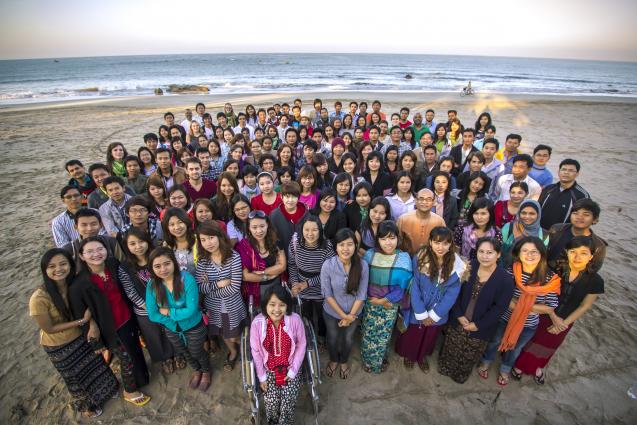Context: Myanmar’s 2014 census report shows that one in every five children aged 10 to 17 were working instead of going to school. This, in turn, lowers the possibility of them getting good jobs and having employment security in the future. Despite many young people working at early ages, the youth (ages 15-24) unemployment rate in 2016, from the ILO’s Key Indicators of the Labour Market was relatively high, at 12.2 per cent, compared to the adult rate of 3.1 per cent. Gender differences also exist, with the youth unemployment rate for the female population being 20 per cent greater than that for males, the figures being 13.3 and 11.1 per cent, respectively.
Implementation of programme/ initiative: ActionAid is an international organization working toward a world free from poverty and injustice; it is currently working with 15 million people across 45 countries. ActionAid Myanmar was established in 2006, in partnership with local and international organizations. The main objective of the ActionAid Myanmar programme is to support intensive training and development of youth in target communities. ActionAid believes that local youth, or the “change-makers”, will succeed where development agencies have failed in mobilizing local communities and facilitating appropriate action on community problems and priorities. ActionAid Myanmar operates in all the seven states and seven regions of Myanmar, and has four priorities: livelihoods and disaster risk reduction, women’s rights, youth and education, and governance.
ActionAid Myanmar’s total budget in 2015 was US$ 6,342,000. Respectively, 69.0 per cent of the figure came from institutional donors such as the European Union, UNICEF, ECHO, UK Aid, and LIFT; 18.5 per cent came from regular giving; 5.5 per cent came from private donors; and 7.0 per cent came from other sources.
Main challenges: The main challenge ActionAid Myanmar faces is a lack of reliable data and analysis on many remote villages in the country. This makes it extremely difficult for the programme to institutionalize a bottom-up approach to national planning and development in Myanmar. As a result, the programme has developed the Village Book concept in which the local youth collect and analyse demographic data on their own villages and are given opportunities to prioritize context specific action plans. These then act as advisory tools for ActionAid Myanmar’s micro-level development plans.
Another challenge is a downward trend in financial support. A suggested reason for this is the new funding concept where the programme encourages donors to support general programming instead of funding on a project-to-project basis.
Results achieved: In 2011, ActionAid Myanmar established a Global Platform training centre in Yangon. The centre provides training and opportunities for young people to become active drivers of change. ActionAid Myanmar has also set up five youth resource centres around the country that serve large numbers of youth through the provision of access to information, networks, personal development and spaces for social work and campaigns.
In 2015, an education strategy was developed, with a focus on rights to education. During that year a total of 2,728 people were engaged in education related activities, including members of school management committees and community members. Also in 2015, and in collaboration with UNICEF, ActionAid Myanmar trained 185 fellows and 227 youth leaders in eight states and divisions to become change agents in their communities through organizing youth activities and representing the voices of youth to other actors including local authorities, NGOs and community leaders .
Moving Forward: In January 2016, ActionAid Myanmar launched a four-year project called “Strengthening a responsive, diverse, and democratic civil society in Myanmar”. The project is funded by the European Union and the overall objective is to build a more equitable and democratic society in Myanmar. The target group is 83 youth and women-led society organizations from rural and ethnic areas, and the aim is to enhance participation in local governance processes and policy dialogue. In the same year, ActionAid Myanmar in collaboration with UNICEF, Myanmar Red Cross, National Youth Congress initiated the country’s first digital platform for youth to share their demands for services and rights and access decision-makers, policymakers and politicians. The platform is available to reach up to 30 million mobile users, with the hope of enhancing youth participation, including for peace and national unity.
Replicability: The success of ActionAid Myanmar is primarily due to its creation of the Village Books in which local youth can contribute to the development of their communities through their involvement in data collection and decision-making processes. Such active engagement of youth is fundamental to the success of programmes. In this context, ActionAid Myanmar, believing that people in poverty are often those whose voices are ignored, works to listen to what people really want and need, and help them to take actions to hold their governments to account.
References:
Background Information:
http://myanmar.unfpa.org/en/news/one-five-children-myanmar-go-work-instead-going-school-new-census-report-reveals
KILM 9th Edition Database from the ILO
ActionAid Myanmar: http://www.actionaid.org/where-we-work/asia-australia/myanmar
http://actionaid.org/sites/files/actionaid/village_book_training_manual_english__0.pdf
https://prezi.com/vtoj2ap3bvro/actionaid-myanmar-child-adolescent-and-youth-programme/?webgl=0
2015 report : https://drive.google.com/file/d/0B9Qt_T8c-wmybHZEaVF4M1duZFU/view
U-report : http://www.actionaid.org/2016/08/u-report-myanmar-giving-youth-voice
Empowering youth and women:
http://www.actionaid.org/2016/01/new-ec-funded-project-empowering-women-and-youth-led-csos-myanmar
Acknowledgments:
This good practice was kindly prepared by Ms. Thanchanok Chaykamhang
Project Details
Date: May 1, 2017
